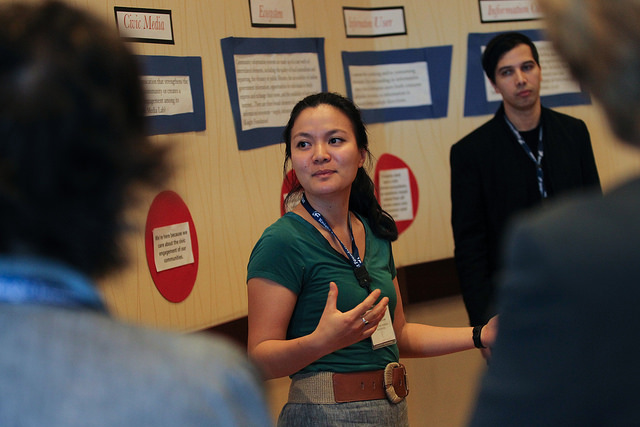
Embracing change: Five key lessons from innovative community foundations
Above, from left to right: Alberto Ibargüen, president of Knight Foundation; Kelly Ryan, CEO of Incourage Community Foundation; Chris J. Daggett, president and CEO of the Geraldine R. Dodge Foundation; and Emmett Carson, CEO of the Silicon Valley Community Foundation. Photo credit: Knight Foundation on Flickr.
As technology continues shaking up the traditional media landscape, it’s leaving gaps and opportunities for community organizations to step in to fill information needs. But legacy news organizations haven’t been alone in facing major shifts. The disruption has affected foundations, too, forcing change and adaptation over the last decade.

RELATED LINKS
“4 new community information investments focus on high-impact projects” by Marika Lynch on KnightBlog.org
“How to open up the data in your community to help solve problems” by Elise Hu on KnightBlog.org
“How to apply human-centered design at home: Lessons from the Media Learning Seminar” by Elise Hu on KnightBlog.org
“Journalism as knowledge: covering solutions to strengthen communities” by Michael D. Bolden on KnightBlog.org
“Strengthening communities: The case for talent, opportunity and place” by Elise Hu on KnightBlog.org
“2014 tech trends that will impact foundations” by Elise Hu on KnightBlog.org
“Going for Goal: Shared knowledge inspires successful Giving Days” by Bahia Ramos on KnightBlog.org
“Using design thinking for community information needs” by Marika Lynch on KnightBlog.org
“Join us – virtually – for a conversatino on community news and information” by Marika Lynch on KnightBlog.org
Knight Foundation announced it will increase its investments in four fast-adapting foundations — Geraldine R. Dodge Foundation, Chicago Community Trust, Incourage Community Foundation of Wisconsin and Silicon Valley Community Foundation — and their targeted efforts to better engage their communities. At the Media Learning Seminar in Miami, leaders from several foundations laid out a few key lessons learned in recent years:
Know your values and be true to them
Organizational and giving decisions can all flow from clarity of values and vision. Incourage has found its focus by building its experimentation around its values. “A long-term vision and core values linked to a permanent commitment to place is the true value proposition for place-based philanthropy,” said Incourage Foundation’s Kelly Ryan.
Co-create with your community
Just as legacy news organizations have learned to better have two-way conversations instead of “one-to-many” broadcasts, successful community foundations are seeking out collaboration more aggressively with community members and grantees.
“The rules of engagement changed,” said Ryan. One of Incourage Foundation’s bigger changes over the last seven years is how it approaches its conversations with community. No longer content with convening meetings in an office, Incourage staffers now try to engage in one-on-one conversations with residents out in the community. “Participant learning, truly understanding co-creation culture and learning is far more important than convening,” Ryan said. The foundation saw the results of this kind of resident-centered decision-making when thousands participated in an effort to repurpose an old newspaper building in Wisconsin Rapids to serve the interests of the community.
Risk and failure become opportunity
Silicon Valley, Dodge and Incourage foundations learned from innovators in various fields — from startup tech companies to digital media thinkers to community organizations — who shared an important trait. They embraced the notion of failing fast and often, because the lessons from failure foster growth and change. Ryan now regularly checks herself by asking: “Is my behavior fostering failure and making it less punitive and acceptable, and how do I influence a fail-fast culture inside my organization?”
Collaborate with community partners
Effective partnering is essential, said foundation leaders. For Dodge Foundation, a place-based organization focused on New Jersey, a central mission has been filling news and information gaps in a state where there’s no shortage of news, but a real shortage of original news sources. But by bringing together community foundations with private foundations and thinking beyond traditional partners, Dodge is helping drive exciting growth in startup news sources in the Garden State. Dodge’s work is better because of its collaborations with Montclair State University and City University of New York, among others, said Dodge Foundation’s Chris Daggett.
“We did some things that are totally unexpected and surprised us … when we forced collaboration. Because by virtue of putting them together, they come up with new ideas and solve new problems,” Daggett said.
Individuals can have a huge impact
In better studying the individual information ecosystems in the communities they serve, foundations learned the power of individual influencers. “People working on little passion areas in their communities gather a huge amount of change and steam,” said Ryan. Since so much of a community’s power dynamics depend on who has access to information and who gets to make decisions based on the information they have, Incourage mapped out news sources down to a granular level. It learned that even a gas station attendant could wield a lot of influence in how information spreads in certain neighborhoods. The same is true in New Jersey, where an individual hurricane blogger with expertise on the New Jersey coast quickly drew a following of close to a quarter of a million people in advance of Hurricane Sandy.
The challenge for foundations now is helping ignite individuals who have passion, and better connecting them with community members. “Where is the passion for an individual? What is it that will make them choose to be engaged in some way? Child care, the environment, what is it? That depends on an intentional, one-on-one conversation,” said Silicon Valley Foundation’s Emmett Carson.
To learn more about the work of these foundations, check out our earlier post.
Elise Hu is a journalist at NPR and a consultant for Knight Foundation.
Recent Content
-
Journalismarticle ·
-
Journalismarticle ·
-
Journalismarticle ·


